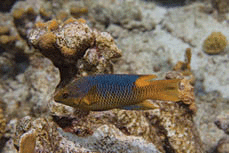Return to 1st Quarter 2024 articles.



The many unique characteristics we see in animals enabling them to survive give evidence of God's design and planning. Our daily posts on Facebook and our Dandy Designs book series show hundreds of examples.
A new example is the hogfish (Lachnolaimus maximus) living in the Atlantic Ocean reefs from the Carolinas to Brazil. You can almost say this fish sees with its skin. Like many animals, the hogfish’s primary method of survival is camouflage. They hide by changing colors and altering skin patterns.
Many animals, such as chameleons, squid, and cuttlefish, have chromatophores, pigment-bearing cells that can change color to match the environment. Hogfish also use chromatophores in their skin to change colors, but they have a layer of opsin, a light-sensing protein, under the chromatophore layer.
The hogfish moves through different background materials as the reef has varied colors and textures with corals, sponges, and sediment. The fish can change its color to match the environment but cannot turn its head to see what color it is. The opsin layer acts as a primitive eye looking at the chromatophores to see that the color matches the surroundings. In that way, this fish sees with its skin.
The design of fish survival in a reef involves a wide variety of techniques. Some can swim rapidly, others bury themselves in the bottom sediment, and others have immunity to stinging organisms. Some fish can fly (glide), some can swim in schools, and some, like the hogfish, can camouflage themselves. Together, they make the reef a place full of life and beauty. That beauty may encourage humans to preserve the world’s reefs as places of great aesthetic worth.
Picture credits:
© Peter Clark/Bigstock.com
